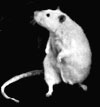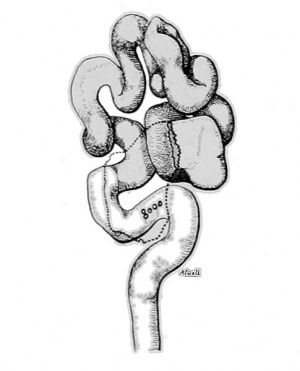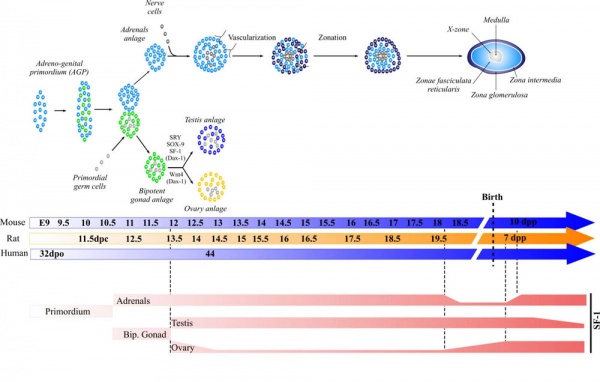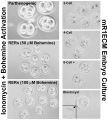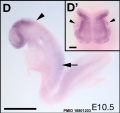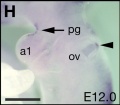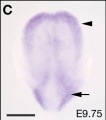Rat Development
| Embryology - 27 Apr 2024 |
|---|
| Google Translate - select your language from the list shown below (this will open a new external page) |
|
العربية | català | 中文 | 中國傳統的 | français | Deutsche | עִברִית | हिंदी | bahasa Indonesia | italiano | 日本語 | 한국어 | မြန်မာ | Pilipino | Polskie | português | ਪੰਜਾਬੀ ਦੇ | Română | русский | Español | Swahili | Svensk | ไทย | Türkçe | اردو | ייִדיש | Tiếng Việt These external translations are automated and may not be accurate. (More? About Translations) |
Introduction
The rat (taxon - rattus) is readily available as inbred, outbred and mutant strains. They have been generally beaten as a model by their rodent mice brethren, as the molecular tools that became available (stem cells, knockout genes, etc).
Rat embryos do have the advantage of being much larger than mouse embryos and easy to breed. Another advantage of rats is in vision development studies, as that retinal development continues postnatally (most vertebrate neurological systems are difficult to access during periods of development). Rat development is also generally 1 day behind that of mouse. (The table below gives details relating to the staging of rat development).
Huber in 1915 first described the early development of the albino rat (Mus Norvegicus Albinus) within the uterus from pronuclear stage to day 9.[1]
Some Recent Findings
|
| More recent papers |
|---|
|
This table allows an automated computer search of the external PubMed database using the listed "Search term" text link.
More? References | Discussion Page | Journal Searches | 2019 References | 2020 References Search term: Rat Embryology | Rat Development |
| Older papers |
|---|
| These papers originally appeared in the Some Recent Findings table, but as that list grew in length have now been shuffled down to this collapsible table.
See also the Discussion Page for other references listed by year and References on this current page.
|
Rat Estrous Cycle
See the review of the rat estrous cycle.[6] One of the best characterised polyestrous reproductive cycles, though different species of rats may differ in reproduction. In general, puberty occurs at 6-8 weeks when the estrous cycle commences each cycle is 4-5 days. The estrous cycle is polyestrous, more than one estrous cycle during a specific yearly time, with an estrous period of approximately 12 hours.
Species Stages Comparison
The table below gives an approximate comparison of human, mouse and rat embryos based upon Carnegie staging.
| Carnegie | Stage | |||||||||||||||||||||||
| Human | Days | 1 | 2-3 | 4-5 | 5-6 | 7-12 | 13-15 | 15-17 | 17-19 | 20 | 22 | 24 | 28 | 30 | 33 | 36 | 40 | 42 | 44 | 48 | 52 | 54 | 55 | 58 |
| Mouse | Days | 1 | 2 | 3 | E4.5 | E5.0 | E6.0 | E7.0 | E8.0 | E9.0 | E9.5 | E10 | E10.5 | E11 | E11.5 | E12 | E12.5 | E13 | E13.5 | E14 | E14.5 | E15 | E15.5 | E16 |
| Rat | Days | 1 | 3.5 | 4-5 | 5 | 6 | 7.5 | 8.5 | 9 | 10.5 | 11 | 11.5 | 12 | 12.5 | 13 | 13.5 | 14 | 14.5 | 15 | 15.5 | 16 | 16.5 | 17 | 17.5 |
| Note these Carnegie stages are only approximate day timings for average of embryos. Links: Carnegie Stage Comparison | ||||||||||||||||||||||||
| ||||||||||||||||||||||||
| Postnatal Animal Models | mouse | rat | pig |
|---|---|---|---|
| Pregnancy period (days) | 18 – 21 | 21 – 23 | 110 – 118 |
| Placenta type | Discoidal, decidual hemoendothelial choroidea |
Discoidal, decidual hemoendothelial choroidea |
Epitheliochorial |
| Litter size | 6 – 12 | 6 – 15 | 11 – 16 |
| Birth weight (g) | 0.5 – 1.5 | 3 – 5 | 900 – 1600 |
| Weaning weight male/female (g) | 18 – 25/16 – 25 | 55 – 90/45 – 80 | 6000 – 8000 |
| Suckling period (days) | 21–28 | 21 | 28–49 |
| Solid diet beginning (days) | 10 | 12 | 12 – 15 |
| Puberty male/female (week) | 4 – 6/5 | 6/6 – 8 | 20 – 28 |
| Life expectancy (years) | 1 - 2 | 2 - 3 | 14 – 18 |
| Table data - Otis and Brent (1954)[7] Links: timeline | |||
Rat oocytes showing metaphase plate[8]
- Links: Rat Timeline
Somite Development
| Maximum Variation | |||||||
|---|---|---|---|---|---|---|---|
| Age Days-Hrs. |
Number of Litters |
Number of Embryos Counted |
Means | All Embryos | One Litter | Standard Deviation |
Coefficient of Variation % |
| 10-12 | 1 | 4 | 8.7 | 6-11 | 6-11 | 2.8 | 32 |
| 10-13 | 1 | 6 1 | 0. 2 | 8-13 | 8-13 | 1.9 | 19 |
| 10-16 | 2 | 12 | 12.4 | 6-26 | 6-26 | 5.8 | 47 |
| 10-17 | 6 | 48 | 12.9 | 4-26 | 7-26 | 3 .3 | 26 |
| 10-18 | 4 | 23 | 14.1 | 6-18 | 9-18 | 3.1 | 22 |
| 10-19 | 1 | 6 | 14 .3 | 12-17 | 12-17 | 1.2 | 8 |
| 10-22 | 3 | 16 | 13.1 | 6-19 | 6-14 | 3.9 | 30 |
| 10-23 | 3 | 17 | 15.2 | 8-18 | 8-18 | 2.4 | 16 |
| 11-00 | 2 | 0 | 14.6 | 10-17 | 10-17 | 1.9 | 13 |
| 11-02 | 2 | 15 | 20 . 9 | 17-22 | 17-22 | 1. 3 | 6 |
| 11-04 | 1 | 10 | 25. 3 | 23-26 | 23-26 | 1.2 | 5 |
| 11-06 | 1 | 2 | 18.0 | 18-18 | 18-18 | .0 | 0 |
| 11-08 | 1 | 8 | 25 0 | 23-28 | 23-28 | 1.9 | 8 |
| 11-09 | 1 | 3 | 22 .0 | 20-25 | 20-25 | 2 . 2 | 10 |
| 11-10 | 2 | 18 | 26.2 | 21-31 | 21-31 | 2.9 | 11 |
| 11-11 | 3 | 26 | 25.6 | 14-29 | 14-27 | 3.2 | 12 |
| 11-12 | 1 | 3 | 26. 7 | 25-28 | 25-28 | 1.2 | 4 |
| 11-14 | 1 | 3 | 21.3 | 21-22 | 21-22 | .6 | 2 |
| 11-15 | 1 | 8 | 23.1 | 17-28 | 17-28 | 4 . 0 | 17 |
| 11-16 | 1 | 7 | 26.7 | 24-28 | 24-28 | 1.3 | 5 |
| 11-17 | 1 | 7 | 26.1 | 25-28 | 25-28 | 1.1 | 4 |
| 11-18 | 3 | 25 | 25 .4 | 19-28 | 19-28 | 1.9 | 7 |
| 11-20 | 2 | 16 | 27.2 | 25-29 | 25-29 | 1.2 | 4 |
| 23 Ages | 44 | 292 | Av 2.2 | Av 13% | |||
| Data Reference[9] Links: rat | somitogenesis | |||||||
Placenta Development
For review of the rat placenta.[10]
Adrenal and Gonad Development
Adrenal and gonad steroidogenic factor 1 expression[11]
Animal Model Differences
The rat is a common model of human development with some developmental and anatomical differences.
- liver lobation with obvious connective tissue septa, less connective tissue in human liver.[12]
- gallbladder absent in rats.[12]
- increased role of hepatic artery in lobular perfusion in humans.[12]
References
- ↑ Huber GC. The Development of the Albino Rat (Mus norvegicus albinus). (1915) J Morphol. 26(2).
- ↑ Kirberger RM, Bester EG, Schulman ML, Janse van Rensburg I & Hartman MJ. (2019). Ultrasonographic evaluation of fetal development in the rat. Theriogenology , 125, 24-29. PMID: 30388467 DOI.
- ↑ Casanova EA, Okoniewski MJ & Cinelli P. (2012). Cross-species genome wide expression analysis during pluripotent cell determination in mouse and rat preimplantation embryos. PLoS ONE , 7, e47107. PMID: 23077551 DOI.
- ↑ Hamanaka S, Yamaguchi T, Kobayashi T, Kato-Itoh M, Yamazaki S, Sato H, Umino A, Wakiyama Y, Arai M, Sanbo M, Hirabayashi M & Nakauchi H. (2011). Generation of germline-competent rat induced pluripotent stem cells. PLoS ONE , 6, e22008. PMID: 21789202 DOI.
- ↑ Fujinaga M, Brown NA & Baden JM. (1992). Comparison of staging systems for the gastrulation and early neurulation period in rodents: a proposed new system. Teratology , 46, 183-90. PMID: 1440421 DOI.
- ↑ Hubscher CH, Brooks DL & Johnson JR. (2005). A quantitative method for assessing stages of the rat estrous cycle. Biotech Histochem , 80, 79-87. PMID: 16195173 DOI.
- ↑ Otis EM and Brent R. Equivalent ages in mouse and human embryos. (1954) Anat Rec. 120(1):33-63. PMID 13207763
- ↑ Webb RL, Findlay KA, Green MA, Beckett TL & Murphy MP. (2010). Efficient activation of reconstructed rat embryos by cyclin-dependent kinase inhibitors. PLoS ONE , 5, e9799. PMID: 20333307 DOI.
- ↑ Landacre FL. and Amstutz MM. Data on the number of somites compared with age in the white rat. (1929) Ohio J. Science. 29(6): 253-259.
- ↑ Furukawa S, Hayashi S, Usuda K, Abe M, Hagio S & Ogawa I. (2011). Toxicological pathology in the rat placenta. J Toxicol Pathol , 24, 95-111. PMID: 22272049 DOI.
- ↑ Val P, Lefrançois-Martinez AM, Veyssière G & Martinez A. (2003). SF-1 a key player in the development and differentiation of steroidogenic tissues. Nucl. Recept. , 1, 8. PMID: 14594453 DOI.
- ↑ 12.0 12.1 12.2 Kruepunga N, Hakvoort TBM, Hikspoors JPJM, Köhler SE & Lamers WH. (2018). Anatomy of rodent and human livers: What are the differences?. Biochim Biophys Acta Mol Basis Dis , , . PMID: 29842921 DOI.
Reviews
Rubinstein NA, Lyons GE & Kelly AM. (1988). Hormonal control of myosin heavy chain genes during development of skeletal muscles. Ciba Found. Symp. , 138, 35-51. PMID: 3058433
Articles
Ferretti VA, Segal-Eiras A, Barbeito CG & Croce MV. (2016). Temporal and spatial expression of Muc2 and Muc5ac mucins during rat respiratory and digestive tracts development. Res. Vet. Sci. , 104, 136-45. PMID: 26850552 DOI.
Ashwell KW. (2015). Quantitative analysis of somatosensory cortex development in metatherians and monotremes, with comparison to the laboratory rat. Somatosens Mot Res , 32, 87-98. PMID: 25393314 DOI.
Ferretti V, Segal-Eiras Á, Barbeito CG & Croce MV. (2015). Muc5ac mucin expression during rat skin development. Eur J Histochem , 59, 2462. PMID: 25820562 DOI.
Kito S, Yano H, Ohta Y & Tsukamoto S. (2010). Superovulatory response, oocyte spontaneous activation, and embryo development in WMN/Nrs inbred rats. Exp. Anim. , 59, 35-45. PMID: 20224168
Sheng Y, Lin CC, Yue J, Sukhwani M, Shuttleworth JJ, Chu T & Orwig KE. (2010). Generation and characterization of a Tet-On (rtTA-M2) transgenic rat. BMC Dev. Biol. , 10, 17. PMID: 20158911 DOI.
Ahmed RP, Haider KH, Shujia J, Afzal MR & Ashraf M. (2010). Sonic Hedgehog gene delivery to the rodent heart promotes angiogenesis via iNOS/netrin-1/PKC pathway. PLoS ONE , 5, e8576. PMID: 20052412 DOI.
Twigger SN, Shimoyama M, Bromberg S, Kwitek AE & Jacob HJ. (2007). The Rat Genome Database, update 2007--easing the path from disease to data and back again. Nucleic Acids Res. , 35, D658-62. PMID: 17151068 DOI.
REINHARDT WO. (1946). Growth of lymph nodes, thymus and spleen, and output of thoracic duct lymphocytes in the normal rat. Anat. Rec. , 94, 197-211. PMID: 21015605
Search PubMed
Search Pubmed: Rat Development
Additional Images
Historic Images
| Historic Disclaimer - information about historic embryology pages |
|---|
| Pages where the terms "Historic" (textbooks, papers, people, recommendations) appear on this site, and sections within pages where this disclaimer appears, indicate that the content and scientific understanding are specific to the time of publication. This means that while some scientific descriptions are still accurate, the terminology and interpretation of the developmental mechanisms reflect the understanding at the time of original publication and those of the preceding periods, these terms, interpretations and recommendations may not reflect our current scientific understanding. (More? Embryology History | Historic Embryology Papers) |
Bailey FR. and Miller AM. Text-Book of Embryology (1921) New York: William Wood and Co.
External Links
External Links Notice - The dynamic nature of the internet may mean that some of these listed links may no longer function. If the link no longer works search the web with the link text or name. Links to any external commercial sites are provided for information purposes only and should never be considered an endorsement. UNSW Embryology is provided as an educational resource with no clinical information or commercial affiliation.
- Rat Genome Database RGD Twigger SN, Shimoyama M, Bromberg S, Kwitek AE & Jacob HJ. (2007). The Rat Genome Database, update 2007--easing the path from disease to data and back again. Nucleic Acids Res. , 35, D658-62. PMID: 17151068 DOI.
| Animal Development: axolotl | bat | cat | chicken | cow | dog | dolphin | echidna | fly | frog | goat | grasshopper | guinea pig | hamster | horse | kangaroo | koala | lizard | medaka | mouse | opossum | pig | platypus | rabbit | rat | salamander | sea squirt | sea urchin | sheep | worm | zebrafish | life cycles | development timetable | development models | K12 | ||
|
Glossary Links
- Glossary: A | B | C | D | E | F | G | H | I | J | K | L | M | N | O | P | Q | R | S | T | U | V | W | X | Y | Z | Numbers | Symbols | Term Link
Cite this page: Hill, M.A. (2024, April 27) Embryology Rat Development. Retrieved from https://embryology.med.unsw.edu.au/embryology/index.php/Rat_Development
- © Dr Mark Hill 2024, UNSW Embryology ISBN: 978 0 7334 2609 4 - UNSW CRICOS Provider Code No. 00098G
